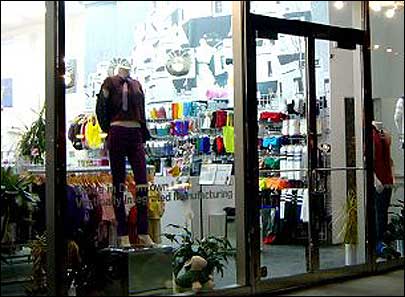Apr 14, 2008American Apparel has a reputation for breaking the rules of retailing in the United States. For one thing, all of its products are manufactured in Los Angeles, and it owns all of its sewing, design and dyeing facilities. For another, although its products are not emblazoned with logos and it does not hire celebrities to promote its products (store employees double as models), its young, hip, urbanite customers are very loyal to the brand. What's more, unlike many other retailers, American Apparel—which operates more than 180 stores in 13 countries—is jumping into item-level RFID tagging and product tracking with both feet, and with a good deal of confidence.
American Apparel representatives first met with RFID technology vendor Vue Technology last August at the RFID Journal Apparel and Footwear Summit in New York City. At that time, the retailer had already begun discussions with RFID hardware provider Motorola and Avery Dennison Retail Information Services.

Within two months of that August meeting, American Apparel had commenced working with Vue, Motorola and Avery Dennison to launch a pilot project in late October, at a store in New York City (located near Columbia University). American Apparel is using Vue's TrueVue software platform to manage Electronic Product Code (EPC) and inventory data, with Motorola readers collecting the data and Avery Dennison providing the RFID tags. The retailer is employing Vue as the project's main integrator, says Gordon Adams, Vue's senior VP of sales.
The chief objective of the RFID system American Apparel is rolling out is to provide improved inventory accuracy and better-stocked sales floors. The company saw quick benefits from the technology: Personnel kept the sales floor fully stocked, and the weekly process of taking inventory of all items in the store—which previously took four workers eight hours to complete—could now be accomplished with just two people in two hours. This gives employees at the pilot site more time to assist customers directly, and carry out other tasks.
Based on these results and improvements, American Apparel believes RFID technology can have a positive effect on other aspects of its business, and has opted to deploy its RFID system permanently at the pilot location, and at the 16 other New York City stores it operates. The company plans to do this over the next three months, then to outfit all of it remaining 128 North American locations as well.
American Apparel has an unusual approach to merchandising, Adams says. "They have one of everything on the floor," he explains—and for American Apparel, "everything" is a lot. The retailer sells basics—such garments as cotton hoodies, T-shirts and skirts—with each style available in a range of colors. One item of every size, color and style is kept on the sales floor, to ensure each garment is fully represented—but that means that once an item sells, that particular model of clothing in that particular size and color is out of stock on the sales floor. To restock the store, employees used to periodically take sales lists from the point-of-sale system and make trips to the stock room, where they'd search for each item as long as the store's inventory showed it was in supply.
For the pilot, employees at the Columbia University store have been utilizing a pool of Avery Dennison AD-220 EPC Gen 2 passive tags, attaching them to items of clothing as they are received from its manufacturing center in Los Angeles. But as the company moves from pilot to deployment, it plans to bring the tagging of items back to the point of manufacture. Workers at the L.A. manufacturing facility will attach RFID-enabled hangtags containing Avery Dennison AD-220 EPC Gen 2 passive inlay to each item of clothing as it is packaged, and an EPC encoded to each garment will be associated with that item's style, size and color.
As shipments leave the distribution center, Motorola XR440 fixed interrogators at the dock doors will read a hand-applied EPC Gen 2 shipping label attached to each case of items, which will then be associated with EPCs encoded to all item tags within that case. All of this data—the case and item EPCs and read events showing timestamps and reader locations—will be transmitted to Vue's TrueVue software platform.
As the tagged cases of product are received at a retail store, another Motorola XR440 fixed interrogator will collect the EPC data and send it to the Vue software running at the store, which will reconcile the received goods with an advance shipment notice sent by the factory. The Vue software will then add the goods to store inventory. Employees will use Motorola MC9090-G RFID handheld readers to take periodic inventory of all items on the sales floor, as they have been doing during the Columbia University store pilot.
Signage in the pilot store lets customers know RFID tags are attached to items for inventory-tracking purposes, but because the tags are removed from items at the point of purchase for reuse, no customers leave the store with tags still attached to their garments. The RFID hangtags will remain on sold clothing, however, once the retailer begins rolling out the technology at its other stores, since tags won't be recollected and reused. As of press time, American Apparel has not responded to questions from regarding whether it plans to render the tags unreadable before customers leave with their purchases.
To date, Adams says, American Apparel has placed an initial order with Avery for 1 million RFID hangtags to supply the 17-store rollout. "But that's only expected to last maybe six months," he says, "so on an annual basis, and as the company expands to stores beyond New York, this will represent many millions of tags."

